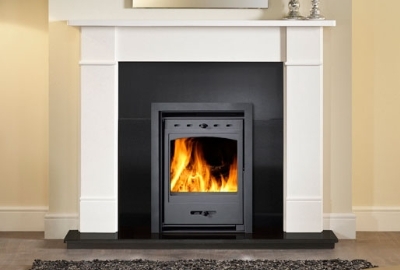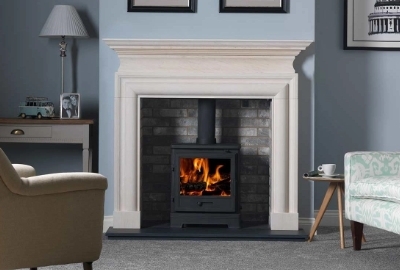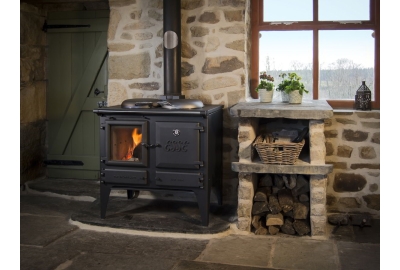The fireplace is one of the most important features of your home. It can be a source of warmth, light and comfort, as well as a focal point in your living room. The right fireplace surround can be an eye-catching feature, it can add value to your property and is essential if you want to impress your friends and family when they walk into your home!
In this article we’ll walk you through all the questions we usually get asked to help steer you towards the perfect fireplace that suits your requirements.
The Different Types of Fireplaces
The first thing you need to know about fireplaces and surrounds is that there are a lot of different types. Not only do you need to choose the fireplace material but you’ll also need to consider the fuel type that is best suited to your home.
- Electric Fireplaces are the most popular fuel type and can often be the least expensive option. They're designed to look like real wood-burning fireplaces but don't require any maintenance or demand the expensive installation fees associated with gas fires & wood burning fireplaces. We offer a variety of electric fireplace materials to suit your home's decorating style from classic marble & stone to painted wood veneer.
- Gas Fireplaces are another popular choice because they create a real flame at the flick of a switch. Gas fireplaces can produce more heat than an electric fireplace so if you are wanting a fireplace in a large room with vaulted ceilings you may wish to consider a gas fireplace.
- Wood-burning or solid fuel fireplaces offer a combination of natural warmth and aesthetic appeal. require regular cleaning and maintenance, and may not be practical if you live in an apartment where you can't burn wood inside. Pellet stoves also fall under this category—they burn compressed sawdust pellets instead of logs but work in much the same way as wood-burning ones with regard to energy efficiency and overall performance.
The Different Fireplace Materials
The different styles of fireplaces & surround is a huge topic of conversation among interior designers. We've done our best to summarise the pros & cons of each fireplace material available. If you want to know more about something specific, feel free to get in touch on our contact page.
- Limestone and marble fireplaces include marble & limestone surrounds and nothing states luxury like a natural stone mantel. Sturdy and chunky looking, limestone surrounds can take on a traditional or modern appearance, whether you want something clean and contemporary, or with delicate carvings. Our range of stone mantelpieces are highly durable and have fantastic heat tolerance. It should be noted that the majority of our natural stone and marble is suitable to be used with electric, gas & solid fuel fires.

- We feature a great range of modern timber fireplaces in our catalogue, we have solid wood, veneer and painted fireplaces available. Timber fireplaces offer great value for money they are durable and can bring warm tones to your living space. With the right clearances, our solid wood fireplaces are suitable to be used for solid fuel fires but veneer or MDF surrounds should only be purchased with electric and gas fires.

- Cast iron fireplaces were incredibly popular for homeowners during the Victorian and Edwardian eras. Our range of cast fireplaces has been updated for modern homes and are suitable for gas, electric & solid-fuel fires. Our beautiful range of period fireplaces comes in lots of sizes of finishes (mainly black or polished). Many cast iron fireplaces are small and compact which dates back to when combination fireplaces would be used in bedrooms, they became known as bedroom fireplaces which is a name they are still referred to today.
What is a Fireplace Insert?
Pairing a fireplace insert with your surround or mantel can create a traditional element to your living space, if you’re wanting to mimic victorian or period-style interiors this is a great option to achieve that goal. Fireplace inserts can be used with a gas burner, solid fuel fire or electric fire, they must be installed within an existing fireplace opening or you can build one to house the depth of the insert. You’ll need a professional fireplace installer to fit a fire surround and insert, there is often building work involved and the fitting of the fire unless you decide upon a decorative (no fire) option.

Fireplace inserts come in many different shapes and sizes so you can choose one that will fit perfectly into the space where you want it installed. There are various types of fireplaces including electric, gas, solid fuel and Bio-Ethanol.
What is a Fireplace Rebate?
The rebate on a fireplace is the distance measured from the back of your wall to the front of the back panel of the fireplace. A deep fireplace rebate means that the insert or back panel that sits within the fireplace opening is brought forward to the inside of the legs of the surround. This creates a space between the insert and the wall. Rebates can be really useful when you’re installing an inset fire onto a flat wall.
How to Measure a Fireplace Rebate
Measuring your rebate is a simple enough process, you will need a tape measure to take this measurement.
The measurement should be taken from the bottom of your mantelpiece leg (inside) to the wall your fireplace is installed against.
If you’re unable to measure the rebate using the method above another way to obtain the rebate measurement is to measure the depth from the face of the leg to the wall behind. This provides you with the ‘outside return’ of your fireplace. You can then measure the ‘inside return’ which is from the leg face to the front of your back panel or insert. To calculate the rebate size, simply subtract the inside return from the outside return.
Measuring the rebate of your fireplace correctly will ensure that you have enough space for the fire you choose when it comes to installing them!

The Different Types of Hearths
If you’re planning to buy a fireplace you’ll likely need a new hearth too, it’s important to know what size of hearth you need and which type of material you should buy. The hearth is the area of your fireplace that's closest to your floor. Most hearths are made from non-combustible stone, but they are other materials that are available.
The width of your hearth should be equal to or greater than the fireplace shelf (the top piece of the fireplace).
The depth of your hearth is usually equal to or greater than 15” (380mm). This often caters for gas, electric & solid fuel fires and your carpet won’t be subject to ash falling if you opt for the latter.
If you’re looking to buy a solid fuel fire you will need to ensure your hearth is suitable for solid fuel. We recommend a hearth that is cut and slabbed so the pieces can contract and expand under the intense heat produced by your wood burner.
We can make most of the hearths we produce to any size you require, simply contact us with the size and the material you’d like and we’ll come back to you with a quote.
What is a Slip Set on a Fireplace?
A slip set is a frame that holds your fireplace surround in place. It can be made of metal or wood and must fit your fireplace opening exactly to achieve a tight seal around the glass. If you are not sure what size slip set will work with your fireplace surround, it's best to ask a professional before purchasing one.
Does a Fireplace Surround Include a Fire?
A fireplace surround or mantel is the structure that surrounds the opening of a fireplace. It differs from a fireplace suite which also includes the hearth, back panel and fire.
When buying a fireplace surround you’ll need to consider the fire type.
Which Chimney Type do I Have?
The chimney type that you have in your home can dictate the type of fire you install. The chimney or flue is used to vent emissions and/or smoke from the fire. Chimneys can be made from brick, clay, concrete, steel or other materials. Knowing which chimney you have on your property is a good place to start when planning to install a fireplace. Once you know the fire type you are able to fit it's time to pick out a fireplace surround.
For more information on how to identify your chimney and the different types of flues in the UK you can visit our dedicated help & advice page - What are the Different Types of Chimneys and Flues?
Knowing The Fireplace You Want
In the end, it’s up to you to decide what type of fireplace surround is right for your home. Knowing what you want can be one of the more difficult steps in finding a fireplace surround that meets your needs.
The best way for us to be able to help is if we know the type of fireplace and sizes that you’re working with. These details will allow us to recommend something perfect for your home! We hope that this article has helped clear up some of the confusion and provided some helpful information on how to find the right fireplace surround for your needs!






